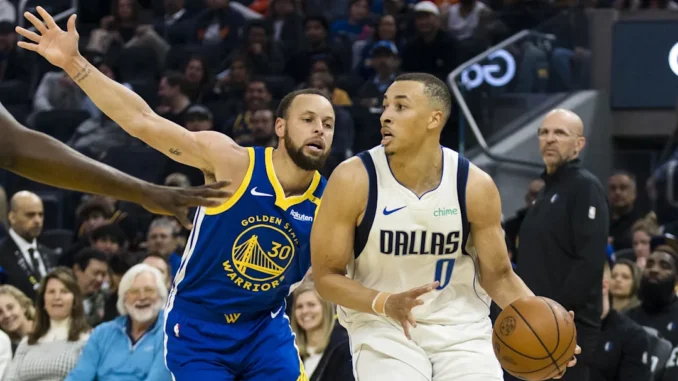
Mavericks’ Offensive Disarray
The Mavericks’ offensive rhythm was completely thrown off throughout the game, especially in the first half. The team struggled to execute its plays effectively, turning the ball over too often and failing to capitalize on scoring opportunities. Luka Dončić, despite putting up some numbers, couldn’t get his teammates involved in any meaningful way. The Mavericks only shot 45% from the field, compared to the Warriors’ 55%. They also hit just 33% of their three-pointers, significantly below their usual mark.
Luka Dončić’s Struggles
Luka Dončić, the Mavs’ star player, had a rough outing. Although he finished with 25 points and 8 assists, it wasn’t enough to keep the team competitive. Dončić’s shooting was off, as he went 9-of-21 from the field and struggled with his outside shooting (1-of-6 from deep). His defense also wasn’t up to his usual standards, as Curry and the Warriors exploited gaps in the Mavericks’ defense.
Dončić looked frustrated at times, unable to find his usual flow, especially as the Warriors pushed the pace in transition. His inability to generate open looks for teammates and get to the rim with his usual ease meant that the Mavericks’ offense became stagnant, a crucial factor in their blowout loss.
Warriors’ Bench Play
One of the key aspects of the Warriors’ victory was the play from their bench. Players like Klay Thompson, Jordan Poole, and Jonathan Kuminga all provided valuable minutes, contributing to both offense and defense. Poole, who has been inconsistent at times, played confidently, hitting timely shots and finishing with 18 points. Kuminga also had a solid game, adding energy on both ends of the floor and finishing with 14 points and 5 rebounds.
This depth was a significant contrast to the Mavericks, who didn’t get much from their reserves. Outside of Dončić and a few contributions from players like Kyrie Irving (19 points), the Mavericks’ bench remained largely ineffective. The lack of depth and consistent scoring from the role players was a glaring weakness throughout the game.
Warriors’ Fast Break and Transition Play
The Warriors capitalized on the Mavericks’ turnovers and converted them into fast break points. The up-tempo style of play that Golden State is known for was in full swing as they racked up 26 fast break points. The Mavericks, on the other hand, were slow to get back in transition and couldn’t stop the Warriors from scoring easy baskets off turnovers and missed shots.
Steph Curry was especially effective in transition, knocking down open threes, and the Warriors were able to stretch their lead quickly. This fast-paced play put constant pressure on the Mavericks, forcing them into mistakes and giving the Warriors easy opportunities to score.
Warriors’ Elite Defense
Golden State’s defense was also exceptional in the win, and it started with their ability to guard the perimeter. The Warriors locked down on the Mavericks’ three-point shooters, preventing them from getting clean looks from beyond the arc. While Dončić and Irving were able to create some offense, the Warriors’ team defense forced them into contested shots and tough decisions.
Defenders like Draymond Green, Andrew Wiggins, and Klay Thompson were all active, ensuring that the Mavericks had very little room to breathe offensively. Green, in particular, played an instrumental role in limiting the Mavericks’ offensive flow, tallying 4 steals and 3 blocks, which helped fuel the Warriors’ transition game.
Coaching Adjustments and the Impact of Jimmy Butler
One of the most talked-about aspects of the game was Jimmy Butler’s impact in his first home game for the Warriors. Butler’s defensive tenacity and offensive versatility helped the Warriors shift the momentum when the game started to get close. His ability to play both sides of the ball allowed Golden State to execute different defensive schemes and offensively play with more confidence.
Coach Steve Kerr’s adjustments during the game were notable as well. He switched between small-ball lineups and traditional big-man setups, utilizing the depth and versatility of his roster to keep the Mavericks on their toes. Kerr’s decision to extend Curry’s minutes early in the second half helped put the game out of reach, and the Warriors took control for good in the third quarter.
Mavericks’ Defensive Lapses
While the Mavericks struggled offensively, their defense was equally problematic. The Warriors shot an efficient 55% from the field, including an outstanding 43% from three-point range. The Mavericks allowed the Warriors to get clean looks at the basket, and poor communication on switches left shooters like Curry and Thompson open for easy shots. With players like Green and Wiggins taking turns getting easy drives to the rim, the Mavericks’ lack of defensive discipline was exposed.
This inability to defend without fouling and their lack of communication on switches contributed heavily to their loss. The Warriors had 30 points off turnovers, and with the Mavs allowing so many open looks, it made it nearly impossible for them to keep up on the scoreboard.
The game served as a reminder of both the Warriors’ offensive firepower and their commitment to defense, but it also highlighted the Mavericks’ ongoing struggles. While the Warriors are firing on all cylinders, the Mavericks face pressing issues on both ends of the floor, particularly in terms of offensive flow, defensive consistency, and overall team depth. As the season moves forward, Dallas will need to make adjustments, or their championship aspirations could be seriously compromised.

Leave a Reply